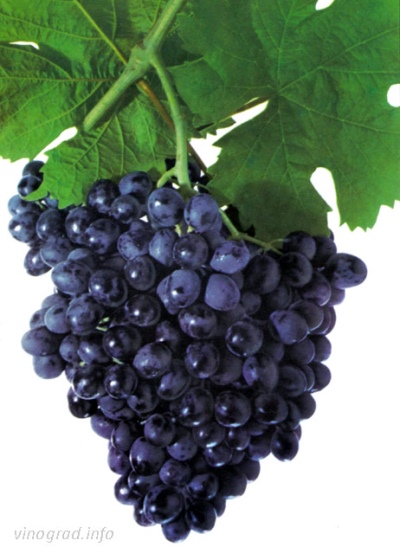
- Authors: "Magarach", Ukraine
- Appointment: dining room
- Berry color: dark blue, with a strong waxy bloom
- Taste: simple
- With bones: Yes
- Ripening period: very early
- Ripening period, days: 120
- Frost resistance, ° C: -18
- Name synonyms: Magarach 372
- Bunch weight, g: 200-500
Today everyone can master the cultivation of grapes, it is enough just to choose the right place and provide proper care. The Early Magaracha variety will be an excellent table decoration.
Breeding history
From the history of breeding it is known that this grape appeared in Ukraine under the brand "Magarach".
Geography of distribution
Today the variety is especially widespread in the Crimea. It is grown in Ukraine, in many regions of Russia.
Description
It is a wonderful table grape with bisexual flowers on the shoots. The bushes are very vigorous.
The best planting scheme for this species is 3x2 m. The percentage of fruitful shoots on the plant is 80. The fruiting factor is 0.53-0.65. On one developed shoot 0.8 bunches are formed, on a fruitful one - 1.3.
Ripening period
From the stage of bud formation to the collection of ripe berries, 120 days pass. This is a very early crop.
Bunches
Bunches can be of two different shapes:
- conical;
- shirokokonicheskaya.
Density can also vary. Sometimes the bunch is loose, and sometimes its density is at an average level. The weight of the bunches ranges from 200 to 500 grams.
Berries
The fruits of the Early Magarach are dark blue in color. A wax bloom is clearly visible on the surface. There are seeds inside the grapes, there are usually 2 to 3 of them. The skin on the fruit is firm, but it breaks. The pulp is quite juicy and fleshy.
The fruit has an oval or round shape. The weight of each is 2.5-2.8 g. The length of the fruit is 19-22 mm, and the width is 16-19 mm.
Taste
The taste can be described as simple.
Yield
The described variety belongs to the high-yielding species. You can collect 90-124 centners per hectare.


Growing features
Vines grown outdoors require mulching. You can use pine bark, compost, or pebbles (it will look great from a decorative point of view too). Mulch is necessary to prevent excessive evaporation of water from the soil and to protect the roots from temperature fluctuations.
In climates with harsh winters, the grower must protect the plant. To do this, you need to remove the vine from the support, lay it on the ground and cover it with spruce branches or special material. In winter, the grapes are not watered or fertilized.
Landing
Grapes are generally not very picky about soil, but they need good drainage. Good yields can be achieved on well-drained sandy loams.
The site is prepared even before planting: weeds are removed and organic matter is added to the soil. Plants are planted at a distance of at least 2 m from each other or 1 meter if the grapes are intended for gazebos. In and between the rows, the soil around the plants is mulched to inhibit the growth of weeds.

Pollination
There is no need to pollinate the plant, since the flowers grow bisexual.
Pruning
During the first few months after planting and until the end of the growing season, the plant is not pruned. It is allowed to grow freely so that it takes root well in the soil and develops a strong root system.
Cut off excess in late winter or early spring when the grapes are dormant. Pruning is carried out for 5-8 eyes. 35-40 pieces are left on the bush.

Watering
Drip irrigation is encouraged. Young plants are moistened at least once a week, while adults do not require as much moisture, since they themselves are able to extract water from the soil.


Top dressing
Plants are periodically fed with aged manure or compost. In the first year, it can be fertilized with general-purpose compounds, they are applied to the soil in spring and summer. From next year, they start using fertilizers with a low nitrogen content. Such dressings should contain a lot of potassium and phosphorus. The application period is spring, when flower buds appear.
Frost resistance and the need for shelter
Shelter is necessary for this variety, since its frost resistance is only -18 degrees.

Diseases and pests
Vines can be attacked by both insects like aphids and fungal infections. In the first case, insecticides are actively used, in the second, fungicides. The proportion is indicated on the package, each manufacturer determines it independently for their drug.

If a grape is exposed to any disease or insect, this always affects its appearance.
Storage
The fruits of this grape can be perfectly stored in the refrigerator, as well as transported over long distances.











































































